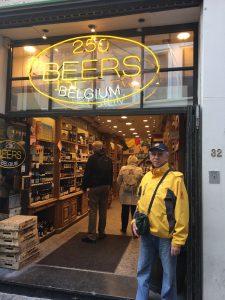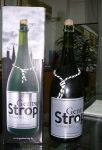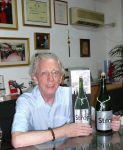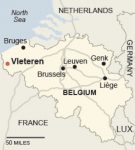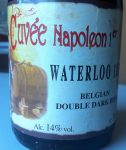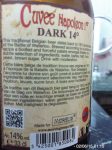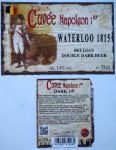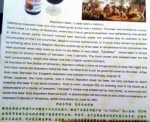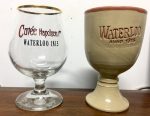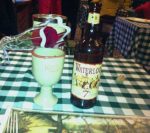Napoleon and Waterloo
A bit more about two beers with Waterloo history
Morel’s Restaurant in Beijing is the only place where you can find the special beer “Cuvée Napoleon”. Earlier the restaurant had also the Waterloo beer.
See here some pics related to the two beers, they are also listed in the Belgian beer page.
See below the descriptions as well as some historical background. I left the text in French as I found it in a couple of sources. I cannot confirm all the “historical” stories are correct.
See more in English here:
http://waterloo-beer.com/en/history
and
http://fermedemontsaintjean.be/en/#
Cuvée Napoleon
“Cuvée Napoleon 1er”, Waterloo 1815” – Belgian Double Dark Beer – Alc. 14%
Delicious Napoleon Beer not only tastes good, it also has a history.
The beer was brewed at a small farm called Le Caillou at Ligny, near Waterloo, where the French general Napoleon was defeated by the British in 1815.
In those years, beer was brewed in winter on large farms, to be consumed the next summer when the farmers went to work on their fields. Water was undrinkable due to pollution in the countryside in Belgium and the Netherlands, while in France they drank wine.
It was called “tafelbier” (table beer) in Dutch and had an alohol content of between 1 and 3%. The farm owner also brewed beer for his own consumption, which was better and had a higher alcohol content.
At the time of the Battle of Waterloo, Napoleon once visited a farm at Hougoumont to stay the night and the farm owner let Napoleon taste his beer. He liked it so much he gave his name to the beer. After that visit, the beer for Emperor Napoleon was brewed on his birthday, August 15.
When Jacques, the farm owner, told a friend Napoleon liked his beer, he was advised to start brewing the beer in his small brewery. That’s what Jacques did, as brewing was in his blood as a descendent of a family of brewers. The beer’s recipe was preserved by the family
A special brew was made on the 200th anniversary of Napoleon’s Battle of Waterloo, which took place on June 18, 1815.
“La Bataille de Hougoumont”
Hougoumont — ou Goumont — est le nom d’un lieu-dit situé sur le territoire de la commune de Braine-l’Alleud, dans la province du Brabant wallon en Belgique (Arrondissement de Nivelles).
The farm of Hougoumont i was held by the Duke of Wellington.
Hougoumont a joué un rôle central dans la bataille de Waterloo dans laquelle les forces alliées des armées commandées par le duc de Wellington (composée de Britanniques, d’Allemands) et celle des Prussiens, commandée par le maréchal Blücher, étaient opposées à l’armée française dite Armée du Nord emmenée par l’empereur Napoléon Ier.
La Ferme du Caillou se situe au hameau du Caillou à Vieux-Genappe, section de la commune belge de Genappe dans la province du Brabant wallon.
Après sa victoire contre les Prussiens lors de la bataille de Ligny le 16 juin 1815, Napoléon Ier installa son dernier Quartier Général à la ferme du Caillou le 17 juin. Il y passa la nuit et y établit ses plans de bataille pour la bataille de Waterloo le matin du 18 juin 1815. La ferme fut ravagée par un incendie le matin du 18 juin 1815.
Histoire La Bière Waterloo
Aujourd’hui, la Waterloo fait partie de la prestigieuse Finest Beer Selection de John Martin, qui entend ainsi préserver le fleuron brassicole du Brabant, et valoriser tout l’art des microbrasseries régionales. Il s’agit là d’une véritable reconnaissance pour cette bière originale et artisanale de qualité. C’est également la garantie de sa pérennité et de sa notoriété grandissante auprès des amateurs de bières fines et exclusives.
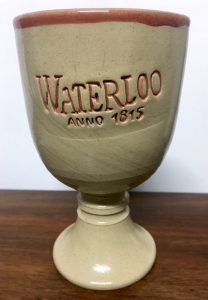
Histoire La ferme de Mont-Saint-Jean
La bière Waterloo est brassée avec passion à la ferme de Mont-Saint-Jean, située sur le champ de bataille de Waterloo. La notoriété de ce site historique, sis à cheval sur Waterloo, Plancenoit et Braine-l’Alleud, remonte bien au-delà des combats du 18 juin 1815.
D’importantes rénovations furent entreprises en 1778. Après la Révolution française, la ferme fut déclarée bien national, pour ensuite être acquise par un propriétaire privé, Grégoire Boucquéau, en 1815. En 1846, la ferme fut finalement vendue à une famille de fermiers originaire des Flandres, les Claus.
La ferme joua un rôle clef durant la Bataille de Waterloo. En effet, le Duc de Wellington décida d’y établir son hôpital de campagne lors du fameux « Bal de la Duchesse de Richmond», organisé le 15 juin 1815 à Bruxelles.
Les jours qui suivirent, environ 6.000 soldats blessés y furent soignés, sous le contrôle du Deputy Inspector Gunning du Royal Army Medical Corps, et de son équipe, d’où l’appellation Hôpital des Anglais ou Ambulance Britannique.
Les soldats britanniques ne furent pas les seuls à être soignés à Mont-Saint-Jean. Durant quatre jours, les médecins et chirurgiens prirent soin sans relâche des nombreux blessés. La scène fut d’une rare violence et selon les témoignages, « les membres amputés s’entassaient aux quatre coins de la cour de la ferme ». Le nombre de victimes s’éleva à 63.000 à la suite des 4 batailles ayant eu lieu entre le 15 et le 18 juin 1815.
Le Prince Guillaume d’Orange-Nassau y fut soigné pour une blessure à l’épaule, avant d’être transféré à Bruxelles. En 1826, son père, le roi Guillaume 1er des Pays-Bas érigea le site de la Butte du Lion en son honneur, juste en face de la ferme. Les aides de camp de Wellington, les colonels Delancey et Gordon, ainsi que son neveu et secrétaire, Lord FitzRoy Somerset, y furent également soignés.
À cette époque, l’eau contenait beaucoup de bactéries. Pour éviter les contaminations, il était plus prudent de boire de la bière. Les brasseries locales situées aux alentours approvisionnèrent les soldats en bière de haute fermentation, comme celles connues aujourd’hui sous le nom de Waterloo, en l’honneur du Prince de Waterloo, titre officiel du Duc de Wellington.
Napoléon donna lui-même le nom bataille de Mont-Saint-Jean à la bataille de Waterloo, prouvant ainsi l’importance du site de Mont-Saint-Jean.
Située à une vingtaine de kilomètres de Bruxelles, la ville de Waterloo est célèbre dans le monde entier pour avoir été le terrain d’une des plus célèbres batailles napoléoniennes: la bataille de Waterloo.
Cette bataille légendaire s’est déroulée le 18 juin 1815 et s’est terminée par la victoire décisive de deux armées : celle des alliés, commandée par le Duc de Wellington (composée de Britanniques, d’Allemands et de Néerlandais) et celle des Prussiens ; toutes deux opposées à l’armée française emmenée par l’Empereur Napoléon 1er.
Les combats n’eurent pas tout à fait lieu à Waterloo mais un peu plus au sud, sur le territoire des communes actuelles de Lasne, Braine-l’Alleud et de Genappe. En France, la bataille a souvent été appelée « bataille de Mont-Saint-Jean », lieu plus précis de l’engagement effectif.
© La bière Waterloo et la Ferme de Mont-Saint-Jean sont des marques déposées et exploitées par la société John Martin s.a, rue du Cerf 191, 1332 Genval, Belgique.
